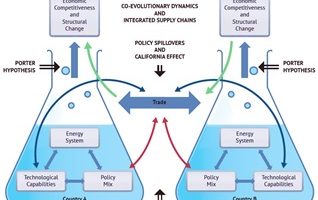Mapping Complex Technological Domains
Energy efficiency (hereafter EE) is one of the three pillars of the EU 2030 Climate and Energy Strategy (EC, 2014), together with the development of renewable energies and the reduction in carbon emissions. In particular, EE has been identified as a preferential means to improve the performance of the national energy system as it could help fostering a sustainable energy transition. The overall performance of the energy system from one side depends on the structural characteristics of countries. At the same time, at the EU level, an increasing effort to spur EE is also pursued through the implementation of national and sector-specific policies to foster eco-innovation. This, in turn, can generate positive effects not only in terms of environmental benefits, but also in terms of economic competitiveness. From the one side, gains in EE might affect the techno-economic structure by providing the economic system new and more resource-efficient production technologies that would allow the system to profit from cost savings. From the other side, the exploration of new technological trajectories might help gaining privileged positions in international markets thanks to first movers’ advantages. In this regard, there is growing interest in understanding the role played by different policy instruments in stimulating and directing technical change in eco-innovation domains and more specifically in the EE branch. Given the growing interest in literature on the potential influence of foreign (innovation and environmental) policies on domestic policy design, and consequently on eco-innovation trajectories, we perform a cluster analysis to investigate if clusters and countries have been influenced by foreign decisions and if they have undertaken a convergence path within each cluster and between clusters. Complexity in the analytical framework guarantees that several aspects related to structural change can be jointly considered.
In order to build our interpretative framework of system transition and structural change processes in the energy efficiency of residential sector, we move from the assumption that the efficiency of the energy system is driven by its structural characteristics, and we consider that its evolution is intimately linked to the rate of generation and adoption of new energy-efficient technologies.
 |
 |
A variety of factors drives eco-innovation, such as environmental regulations, investments for the improvement of technological capabilities, knowledge diffusion, good institutions and cooperation.
From a more general perspective, the design of policy mix might contribute to changing the structure of the socio and techno-economic systems. While innovation policy tends to stimulate innovative efforts of industries and firms to enhance their competitiveness and international performances, transition policy is meant to increase the sustainability of the overall socio-economic system, creating a market for more sustainable goods and services. In a systemic approach, three different international channels are relevant: a learning by exporting effect, a gains from trade effect, and market integration and sustainable supply chains.
EU countries can be clustered according to four dimensions: energy system, technological innovation, policy mix design, and international competitiveness. Almost all EU countries are demand-pull oriented, with the only exceptions of Finland and Ireland, which have a very high unbalanced policy mix towards technology-push measures. Although this convergence in policy mix design, countries appear to be highly differentiated in their degree of innovative performance and trade specialization in this field. According to our analysis, the different internal and external mechanisms shaping EE systems do not appear to act in a deterministic way. On the contrary, the European energy efficiency system (in the residential sector) appears to have the characteristics of a complex system that exhibits emergent properties that are specific to individual country systems. Hence, the energy efficient transformation of economic systems doesn’t necessarily involve the convergence to a common development pattern, because the quality of interactions between different elements both within and outside the system can be highly specific.
Change in national energy efficiency w.r.t. t-5 (1997 and 2012)

Note: the diameter of each circle is given by the standard deviation within each cluster. The larger the diameter, the greater are intra-cluster differences.
EE patent Balassa index (1997 and 2012)

EE export Balassa index at cluster level (1997 and 2012)




